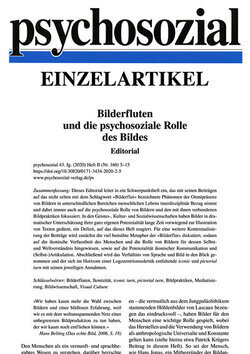11 Seiten, PDF-E-Book
Erschienen: Juli 2020
Bestell-Nr.: 26406
https://doi.org/10.30820/0171-3434-2020-2-5
Sandra Plontke, Astrid Utler & Carlos Kölbl
Editorial (PDF)
Bilderfluten und die psychosoziale Rolle des Bildes
Sofortdownload
Dies ist ein E-Book. Unsere E-Books sind mit einem personalisierten Wasserzeichen versehen,
jedoch frei von weiteren technischen Schutzmaßnahmen (»DRM«).
Erfahren Sie hier mehr zu den Datei-Formaten.
Dieses Editorial leitet in ein Schwerpunktheft ein, das mit seinen Beiträgen auf das nicht selten mit dem Schlagwort »Bilderflut« bezeichnete Phänomen der Omnipräsenz von Bildern in unterschiedlichen Bereichen menschlichen Lebens interdisziplinär Bezug nimmt und dabei immer auch auf die psychosoziale Rolle von Bildern und den mit ihnen verbundenen Bildpraktiken fokussiert. In den Geistes-, Kulturund Sozialwissenschaften haben Bilder in dramatischer Unterschätzung ihrer ganz eigenen Potenzialität lange Zeit vorwiegend zur Illustration von Texten gedient, ein Defizit, auf das dieses Heft reagiert. Für eine weitere Kontextualisierung der Beiträge wird zunächst die viel bemühte Metapher der »Bilderflut« diskutiert, sodann auf die ikonische Verfasstheit des Menschen und die Rolle von Bildern für dessen Selbstund Weltverständnis hingewiesen, sowie auf die Potenzialität ikonischer Kommunikation und (Selbst‑)Artikulation. Abschließend wird das Verhältnis von Sprache und Bild in den Blick genommen und der sich im Horizont einer Logozentrismuskritik entfaltende iconic und pictorial turn mit seinen jeweiligen Annahmen.
Abstract:
This editorial introduces the current edition of psychosozial dedicated to the notion of Bilderflut. The notion of Bilderflut (literally a »flood of images« in German) speaks to the omnipresence of images in various aspects of human life and to the psychosocial roles played by images and image-related practices. Within the social sciences, images have long been dramatically underappreciated, being seen primarily in their role as illustrations of text. The current edition is an attempt to address this deficit. In order to further contextualize the contributions, the metaphor Bilderflut which is widely used is discussed. Then the iconic constitution of humans and the role of images for their selfand world-understanding and the possibilities of iconic communication and (self‑)articulation are indicated. Finally the relations between language and image are focused and the iconic and pictorial turn with their respective assumptions within the horizon of a critique of logocentrism.
Abstract:
This editorial introduces the current edition of psychosozial dedicated to the notion of Bilderflut. The notion of Bilderflut (literally a »flood of images« in German) speaks to the omnipresence of images in various aspects of human life and to the psychosocial roles played by images and image-related practices. Within the social sciences, images have long been dramatically underappreciated, being seen primarily in their role as illustrations of text. The current edition is an attempt to address this deficit. In order to further contextualize the contributions, the metaphor Bilderflut which is widely used is discussed. Then the iconic constitution of humans and the role of images for their selfand world-understanding and the possibilities of iconic communication and (self‑)articulation are indicated. Finally the relations between language and image are focused and the iconic and pictorial turn with their respective assumptions within the horizon of a critique of logocentrism.
Sandra Plontke, Astrid Utler & Carlos Kölbl S. 5–15Editorial (PDF)
Bilderfluten und die psychosoziale Rolle des BildesPatrick KrügerS. 16–30Vom Kultbild zum Stifterkult (PDF)
Wie Bilder zur Konstruktion religiöser Stifterfiguren beitragenSandra del PilarS. 31–44Sehnsucht nach Leben (PDF)
Die Konsequenzen eines uralten Traums in der bildenden KunstAbigail Nieves DelgadoS. 45–56Facial recognition technologies and the new physiognomic era (PDF)
Sabine MollerS. 57–69Wie schreiben Filme (Familien-)Geschichte? (PDF)
Ein Essay zu den sozialen Bezugsrahmen von populären BewegtbildernMarc DietrichS. 70–83Perspektiven einer Audiovisuellen Grounded-Theory-Methodologie und ihr Potenzial im Forschungsfeld »digitale Jugendkulturen« (PDF)
Thomas AuchterS. 87–94Zur Psychoanalyse der Corona-Krise (PDF)
psychosozial 160 (2020), 87-94 Martin WeimerS. 95–101Eine Corona-Figuration (PDF)
Robert HeimS. 102–107Keep your distance! (PDF)
Schopenhauers Stachelschweine heute - ein Lob der EinsamkeitLorenz BöllingerS. 111–129Terrorismus verstehen (PDF)
Rolf HaublS. 130–138»Selbst die Hölle möchte der Mensch verstehen« (PDF)
Empathie und GrausamkeitGalina HristevaS. 139–141Rezension von: Marco Conci (2019). Freud, Sullivan, Mitchell, Bion, and the Multiple Voices of International Psychoanalysis. (PDF)
Jenseits der Schismata: Von der Kraft psychoanalytischer Intersubjektivität und Internationalität
Bilderfluten und die psychosoziale Rolle des BildesPatrick KrügerS. 16–30Vom Kultbild zum Stifterkult (PDF)
Wie Bilder zur Konstruktion religiöser Stifterfiguren beitragenSandra del PilarS. 31–44Sehnsucht nach Leben (PDF)
Die Konsequenzen eines uralten Traums in der bildenden KunstAbigail Nieves DelgadoS. 45–56Facial recognition technologies and the new physiognomic era (PDF)
Sabine MollerS. 57–69Wie schreiben Filme (Familien-)Geschichte? (PDF)
Ein Essay zu den sozialen Bezugsrahmen von populären BewegtbildernMarc DietrichS. 70–83Perspektiven einer Audiovisuellen Grounded-Theory-Methodologie und ihr Potenzial im Forschungsfeld »digitale Jugendkulturen« (PDF)
Thomas AuchterS. 87–94Zur Psychoanalyse der Corona-Krise (PDF)
psychosozial 160 (2020), 87-94 Martin WeimerS. 95–101Eine Corona-Figuration (PDF)
Robert HeimS. 102–107Keep your distance! (PDF)
Schopenhauers Stachelschweine heute - ein Lob der EinsamkeitLorenz BöllingerS. 111–129Terrorismus verstehen (PDF)
Rolf HaublS. 130–138»Selbst die Hölle möchte der Mensch verstehen« (PDF)
Empathie und GrausamkeitGalina HristevaS. 139–141Rezension von: Marco Conci (2019). Freud, Sullivan, Mitchell, Bion, and the Multiple Voices of International Psychoanalysis. (PDF)
Jenseits der Schismata: Von der Kraft psychoanalytischer Intersubjektivität und Internationalität

